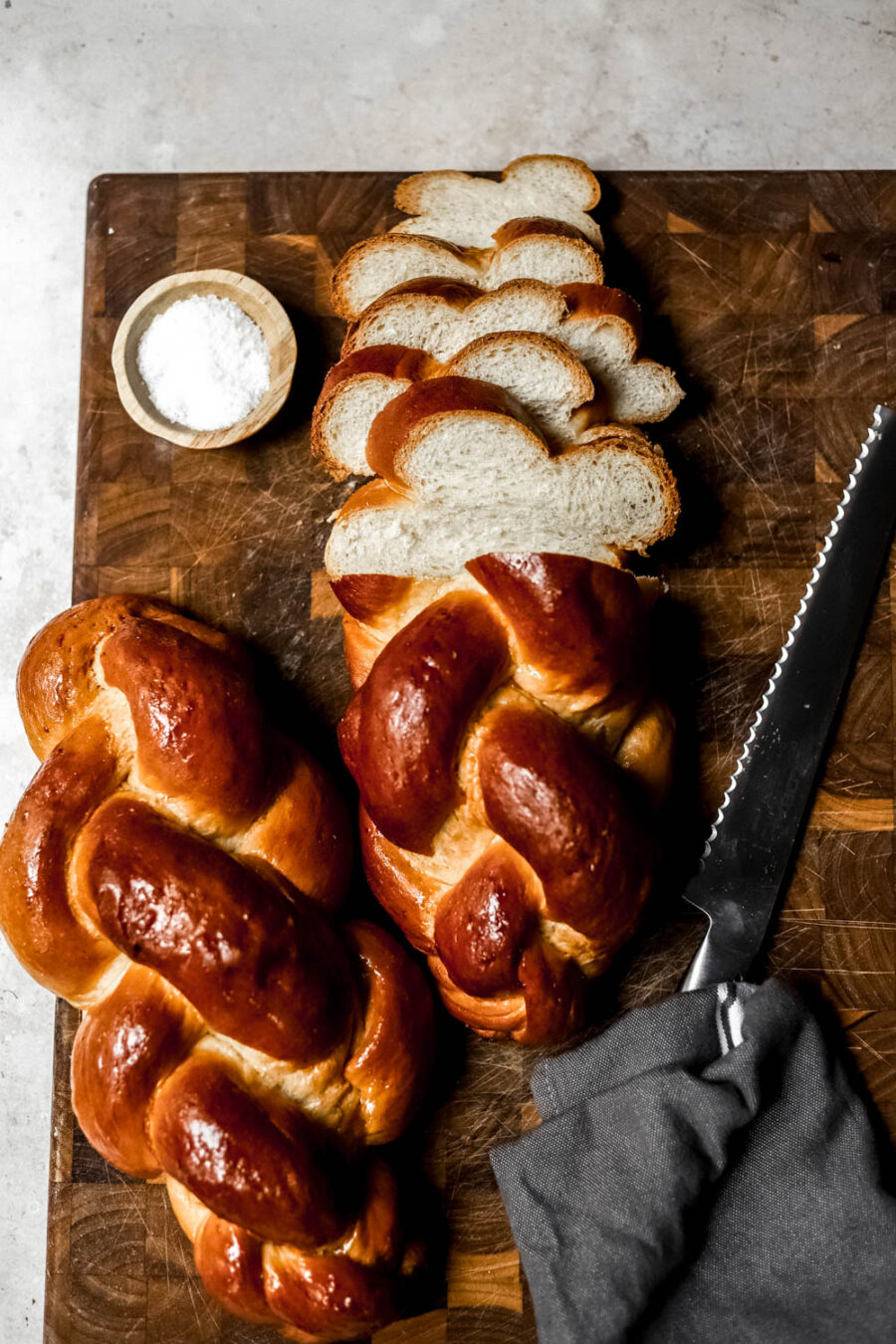
The Best Vegan Challah Bread – also known as “water challah” is made without eggs or honey, but has the soft pillowy texture that we all know and love. This vegan challah comes together in one bowl, and doesn’t require any fancy tools or equipment. Feel free to make a traditional braid, round shape, or even portion it off into soft challah dinner rolls!
How to make Vegan Challah (Water Challah)
This is the most streamlined, simple method I’ve developed to making great Vegan Challah Bread from scratch. First you’ll start by dissolving the yeast in lukewarm water and granulated sugar, in a large bowl. Then, we add the neutral oil (like avocado oil, grape seed, or canola oil), and whisk to combine. Lastly, I add unbleached all purpose flour and kosher salt to the same bowl.
I use a wooden spoon, or a Danish dough whisk to begin incorporating the dry ingredients. When the mixture get too thick to mix with a spoon, I use clean hands to begin pinching the ingredients together until no dry streaks on flour remain. I cover the bowl with plastic wrap, and let the dough autolyse for 10 minutes. This step allows the flour absorb the liquid, and creates a smoother dough, and better gluten development.
Then, with clean hands, I knead the dough on a clean work surface. The dough may be a bit sticky at first, but avoid adding any more flour. Continue kneading the dough for about 5-7 minutes until the surface of the dough is smooth, and the dough is elastic. Wash your mixing bowl out, dry it, and drizzle about 1 teaspoon of neutral oil into the bowl. Place the dough ball into the oiled bowl, and cover with plastic wrap.
Allow the dough to rise at room temperature (about 72-76 degrees F), until the dough has doubled in size. This should take about 1.5 – 2 hours.
From here, you’re going to divide the dough into 2 equal pieces. Then, depending on the braid you’re doing, divide the dough into 3, 4, 5, or 6 equal pieces. Roll each piece into a long rope, and braid! Repeat the same process with the second half of dough.
Place the shaped loaves on a baking sheet lined with parchment paper. Spray a large piece of plastic wrap with nonstick cooking spray, and cover the loaves. Allow the loaves to proof (rise) at room temperature until puffy and jiggly, about 1.5 hours.
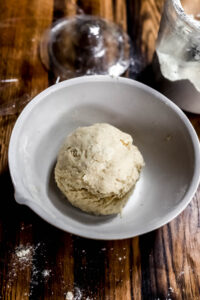
shaggy dough
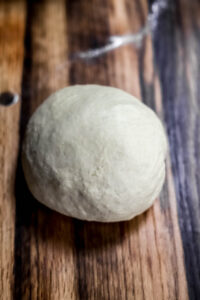
smooth dough after 5-7 minutes of kneading
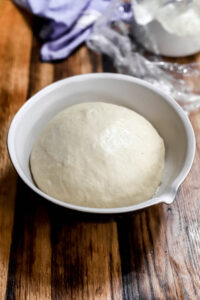
risen dough
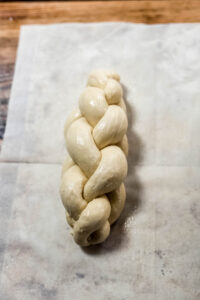
shaped challah loaf – before proof
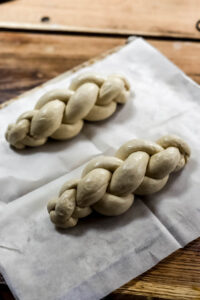
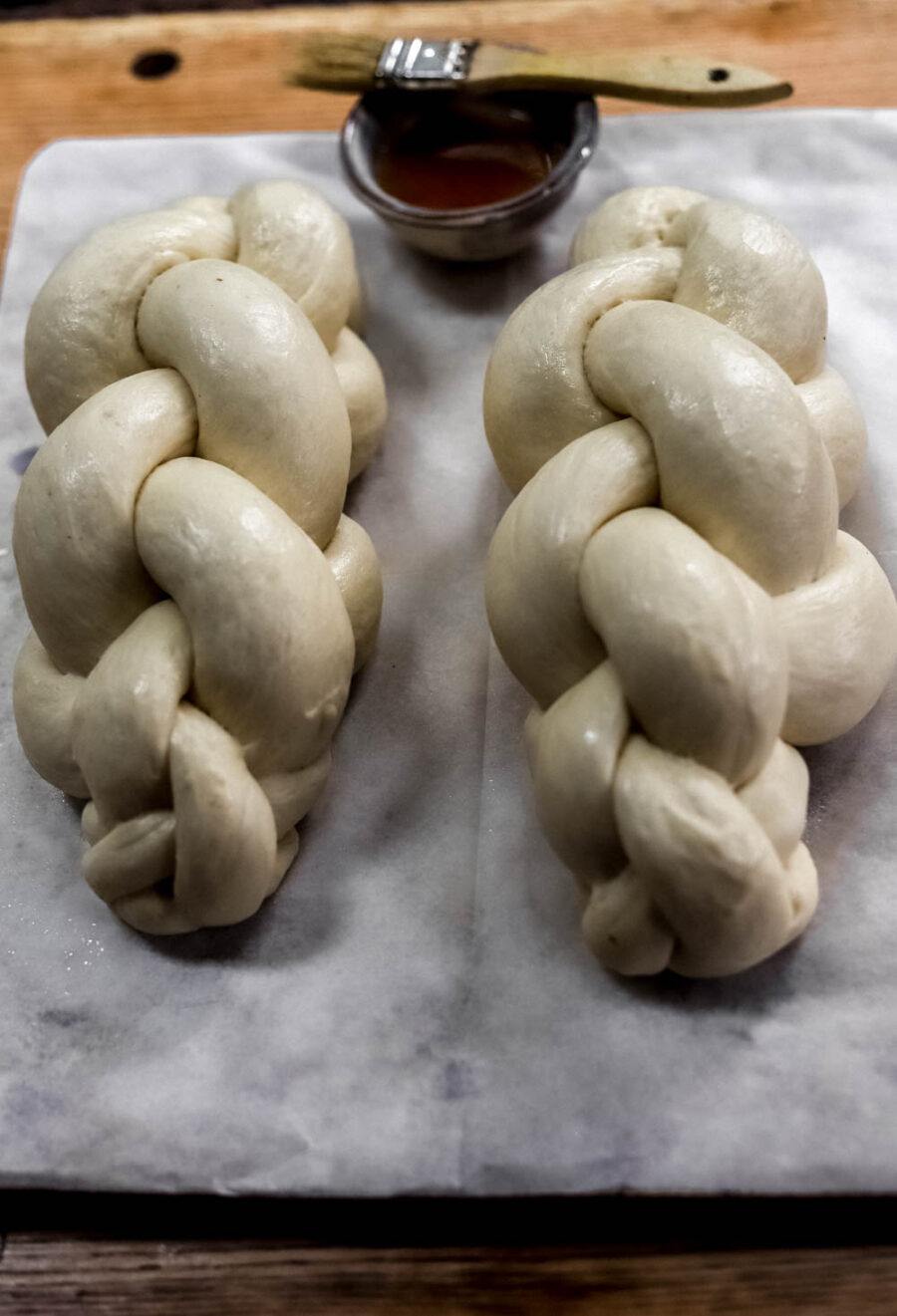
risen loaves, ready to be baked
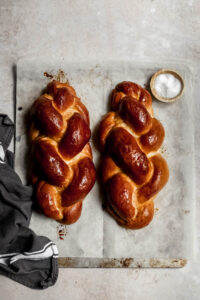
Vegan Egg Wash Substitute
Want the signature shiny challah crust, but without the egg? There are a few different options.
Just before baking the vegan challah bread, brush the proofed loaves with nut milk, oil, maple syrup, or thinned apricot jam for a shiny crust. My recent favorite is the thinned apricot jam. Halfway through the bake, I brush on a second coat of the jam mixture, for extra shine.
Leave the loaves plain, or sprinkle with traditional sesame seeds, poppy seeds, everything-but-the-bagel seasoning, or flakey sea salt.
Bake the Vegan Challah bread at 350 degree F for about 40-45 minutes, until the crust is deeply golden brown.
Tools
Like most of my recipes, I want to keep this bread making process as simple as possible. That means that you won’t need any fancy stand mixers or bread machines to make this really delicious vegan challah bread. The only tools you’ll need are a large mixing bowl, a whisk, wooden spoon, and a large surface for kneading the dough.
That being said, if you already own a stand mixer, you can absolutely use it here. After all of ingredients are combined, you’ll knead the dough on speed 2-3 for about 5-7 minutes until the surface of the dough is smooth and elastic.
How to properly measure ingredients when baking
This is a really hotly debated topic in baking. My personal take is that it FAR more accurate and professional to use a kitchen scale, and weigh out ingredients when baking. Especially when baking bread! When you weigh out your ingredients precisely, you’re more likely to get professional, consistent results.
Of course, not everyone has a kitchen scale (though you should!). If you’re using volume measures (measuring cups and spoons), I have a few tips to guarantee a more accurate measurement.
- when measuring flour, be sure to aerate the flour in the canister first, using a spoon or a scoop. Flour tends to settle, so you want to scoop and mix it around before measuring.
- always, scoop and level your flour. For righties, hold the measuring cup in your left hand, and the a large spoon or scoop in your right hand. Place large scoops of flour gently into the measuring cup, overfilling it. Then use the straight edge of a knife to level off the measuring cup.
- the same rule applies to measuring spoons! make sure that you always level off the top of the spoon when measuring ingredients like baking powder and baking soda.
Ingredients
Unbleached all purpose flour or bread flour – For the best vegan challah bread, I use unbleached all purpose flour from King Arthur Baking Company. It has a higher protein content than most AP flours. You could use bread flour if that’s what you have. If you want to add whole grain flour, replace 50g of the total flour amount with the whole grain flour of your choice. Do not substitute the total amount of flour for whole grain flour, as the results will vary greatly, and you will likely end up with a much more dense challah.
Dry active yeast – Yeast makes our bread rise! It gives our bread the signature lift and airiness! I prefer to use dry active yeast because it gives the vegan challah a really light, airy crumb. It is also the most common variety of yeast that is sold in every grocery store, in the baking aisle. My favorite brand is Red Star Yeast – I love the quality of their product and the consistent professional results.
- What about instant yeast? Is there a difference between instant yeast and dry active yeast? In short, yes! Dry active yeast usually needs to be dissolved in water before using, and instant yeast can be added directly to other ingredients. I find that instant yeast also makes dough rise faster. So if that’s all you can find, keep a close on the clock so that your dough doesn’t overproof, because your dough will likely proof faster.
Water – I use filtered, room temperature water. A lot of tap water is teated with fluoride and chlorine, and other chemicals these days. These chemicals can affect fermentation, so play it safe and use filtered or spring water for bread making. The temperature of the water should be around 80 degrees F – not too cool and not too warm.
Sugar – granulated sugar gives this vegan challah its signature sweetness. Don’t substitute with maple syrup or honey as this affects the overall moisture level in the dough.
Neutral Oil – For this recipe, I use a neutral tasting oil like avocado, grape seed, vegetable or canola oil. I wouldn’t use an extra virgin olive oil here because it has a strong fruitiness that overpowers the flavor of the bread.
Kosher Salt – I use Morton’s kosher salt in all of my bread recipes. If you are using Diamond Crystal, add another 4 grams of salt.
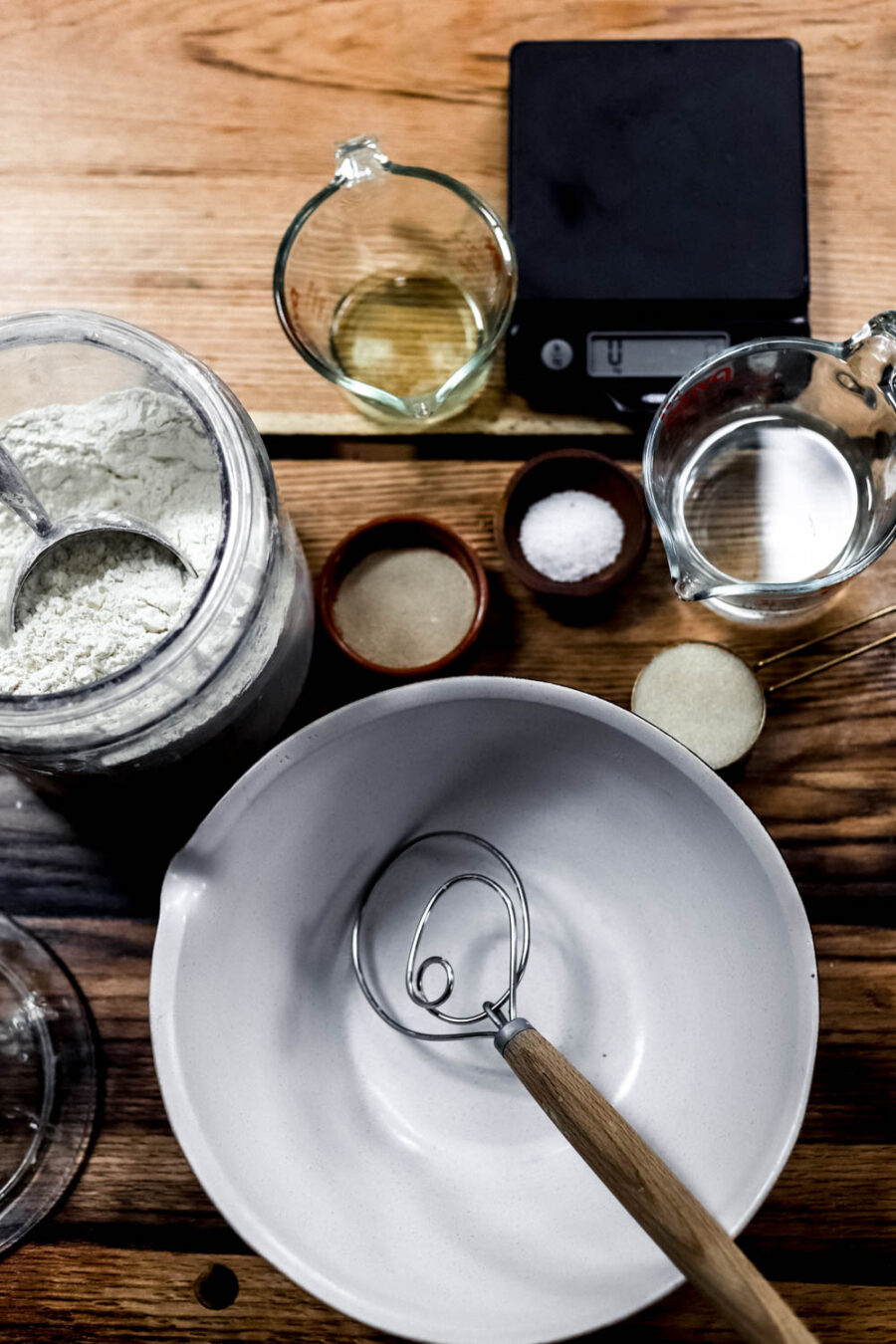
More Vegan Bread Recipes
Overnight Whole Wheat Sandwich Bread
How to Knead Bread by Hand
It’s great if you have a stand mixer, but I love giving you recipes that don’t require any fancy or expensive equipment. Kneading this Vegan Challah Bread dough by hand is actually super simple.
After your dough has risen at room temperature by about 1/3, i pour the dough out onto a very lightly floured work surface, like my clean countertop. I use a metal or plastic dough scraper as I go to help handle the dough as well.
Bring the top edge of the dough into the midline, and push away from you. Then give the dough a 90 degree turn, bring the top down again, and press away. Rotate 90 degrees, bring the dough in, and press away. This motion takes practice, but you’ll get it in no time!. If the dough sticks at all, use the bench scraper to scrape the dough up. Continue to knead the dough until the surface is smooth and elastic, about 5-7 minutes.
Try not to add any additional flour while you knead the dough. Instead use the bench scraper as a nonstick 3rd hand!
If the dough loses elasticity or starts to tear, cover the dough with a clean kitchen towel, and let it rest on the work surface for 5 minutes. This allows the gluten to relax, and makes the dough easier to work with. Come back, and finish kneading.
Different Ways to shape Challah Bread
One of the greatest things about challah bread dough is that it is SO versatile!
You can shape the dough into:
- traditional braids
- round spirals
- individual dinner rolls topped with seeds or sea salt
- Babka style with Nutella, chocolate, or jam
- burger buns
- cinnamon roll style – filled with softened butter, cinnamon, sugar, and topped with a simple powdered sugar glaze
How to Store Vegan Challah Bread
Most Challah will be eaten up so quickly, you don’t have to worry about it going bad. That being said, store any leftover challah in an airtight container or bag at room temperature for up to 4 days.
Freshly baked and cooled loaves can also be frozen in an airtight bag or tightly wrapped in plastic, either whole or sliced. Allow whole loaves thaw completely, and warm up in a 350 degree oven for 15 minutes for that freshly baked taste. Or take out single slices one at a time, and pop right into the toaster.
Challah makes INCREDIBLE toast the next day, or even better, French Toast!
Make sure to tag me @lions.bread on Instagram and comment below if you make this Vegan Challah Bread (Water Challah). To pin this recipe and save it for later, you can use the button on the recipe card or on any of the photos above. Happy baking!
Make this bread? Leave a comment below!
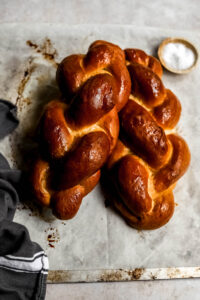
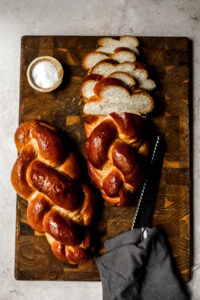
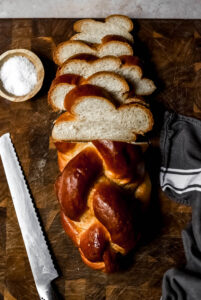
The Best Vegan Challah Bread (Water Challah)
The Best Vegan Challah Bread - also known as water challah is made without eggs or honey, but has the soft pillowy texture that we all know and love. This vegan challah comes together in one bowl, and doesn't require any fancy tools or equipment. Feel free to make a traditional braid, round shape, or even portion it off into soft challah dinner rolls!
Ingredients
- 1 ¼ cups water, room temperature 295 g
- 1 tablespoon dry active yeast 10 g
- ⅓ cup granulated sugar 65 g
- ⅓ cup neutral oil (grape seed, avocado, canola oil) 73 g
- 5 cups unbleached all purpose flour 625 g
- 1 tablespoon kosher salt 15 g
Instructions
In a large bowl, combine the room temperature water, dry active yeast, and granulated sugar. Whisk to dissolve the yeast into the water. Let stand for 3 minutes.
To the bowl, add the neutral oil, whisk to combine. Then add the unbleached all purpose flour and kosher salt to the bowl. Use a wooden spoon, or Danish dough whisk, to incorporate the flour into the wet ingredients. Use your clean hands to pinch the dough until there are no dry streaks of flour left. The dough will be shaggy. Cover the bowl with plastic wrap, and let autolyse (sit) at room temperature for 10 minutes.
Pour the dough out onto a clean work surface, and begin kneading the dough by hand. See above for tips on How to Knead Bread Dough. Knead for 5-7 minutes until the surface of the dough is smooth, and the dough is elastic. Avoid adding any extra flour. If the dough sticks, use a bench scraper to scoop it up. As you knead the dough, it will become less sticky.
Clean out the bowl, and drizzle about a teaspoon of the neutral oil into the bowl, to coat. Place the ball of dough into the oiled bowl, and cover with plastic wrap. Let the dough rise at room temperature for 1.5 - 2 hours, until the dough has doubled in size.
Line a baking sheet with parchment paper. Set aside. Pour the dough out onto a clean work surface, and divide the dough into 2 equal pieces. Divide each piece of dough into either 3, 4, 5 pieces, and roll each piece out into a rope about 12-14 inches long.
Pinch the ends of the ropes together. Braid the ropes of dough, forming a loaf. Pinch the other ends together, and tuck under. Head to instagram (@lions.bread) for shaping and braiding tutorials. Repeat with the second half of dough. Place the loaves onto the parchment lined baking sheet.
Spray a large piece of plastic wrap with nonstick cooking spray. Drape the plastic over the loaves, oiled side down. Let proof (rise) at room temperature for about 1.5 hours until the dough has visibly risen, is jiggly, and puffy. Preheat the oven to 350° F.
Brush the tops of the challahs with either nut milk, thinned apricot jam, maple syrup, or egg for a shiny crust. Brush on another coat of thinned jam or maple syrup halfway through baking for extra shine. Bake for 35-40 minutes, rotating 180° halfway through for even browning, until the crust is deeply golden brown. Allow to cool completely before slicing or tearing.
*This post contains affiliate links. This means that I get a small percentage of the purchase price at no extra cost to you. Thank you for continuing to support the brands that make Lion’s Bread possible.


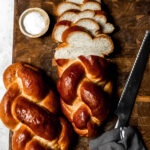
Lisa says
Made it within an hour of seeing the post. It’s AMAZING. I did the mixing in my stand mixer, let it autolyse, then kneaded it in there. SO AMAZING. This recipe comes together quickly and easily, and the end result? Chef’s kiss. Wait, Bubbe’s kiss! I hope it makes it to tomorrow. Instructions for keeping this for a few days are absolutely not needed.
LeAnne says
You are on it! I’m so glad you loved it Lisa, and thank you for taking the time to review my recipe, I REALLY appreciate it 🙂